MATSUDA Gonroku’s Maki-e Studio; Related Materials and Items
MATSUDA Gonroku and the Six Artists and Artisans
*The Arabic numerals in the commentaries indicate the numbers on the acrylic cubes in the showcases.
Left showcase
1st shelf from the top

MATSUDA Gonroku’s tools
Since early times, tools used by master artists show original improvements. Those who have mastered an art, including craftspeople, have an excellent aptitude. They have improved their tools rationally, creatively, and beautifully.
―――From The Book of URUSHI by MATSUDA Gonroku
Spatulas and Brushes
Spatulas are used for groundwork preparation, and lacquer coating and compounding. Made of metal, bamboo, wood, or whalebone, different types of spatulas are used for different purposes depeding on material hardness and tool elasticity. Each artist defines shapes of spatulas according to his purposes. At times he produces one himself. In Tokyo wooden spatulas are made of cypress, while magnolia, “katsura,” and peegee hydrangea are used in Wajima and other regions. There are various types of brushes for different purposes such as coating, undercoating and final coating.
1:Kujira bera: Made of baleen of baleen whale, kujira bera (lit. whale spatula) is very flexible and indispensable for a neat finish of the coating edge.
2:Brush modeled after one from the Heian period discovered during the restoration of Chuson-ji Temple’s Golden Hall. Made by lacquer-brush maker Izumi Seikichi.
3:Spatula made of cypress bark. Can be used also as a brush. Made in Wajima.
4:Brushes used only for final coating. The recommended lacquer brush is one that uses human hair, particularly that of women. Because bristles fill the handle up to its end, you can use the brush even after the bristles wear off by shaving off the handle like sharpening a pencil. There are faint tooth marks on the handle made when the artist held the brush in his mouth to use both hands for other tasks.
5:Brushes used only for undercoating.
6:Brushes for fine application.
7:Small brushes
8:Ashirai kebo (lit. treatment brush): A kind of brush made of fur of horses, weasels, or squirrels for sprinkling gold/silver dust particles. Used for achieving fine shadings with maki-e particles. Artists use various ashirai kebo with different thickness and length depending on purposes and particle volume.
2nd shelf

Maki-e brushes, powder pipes, etc.
9:Tortoiseshell spatula for washing maki-e brushes.
10:Brushes for “hikkaki” (scratching) made of wire of different sizes.
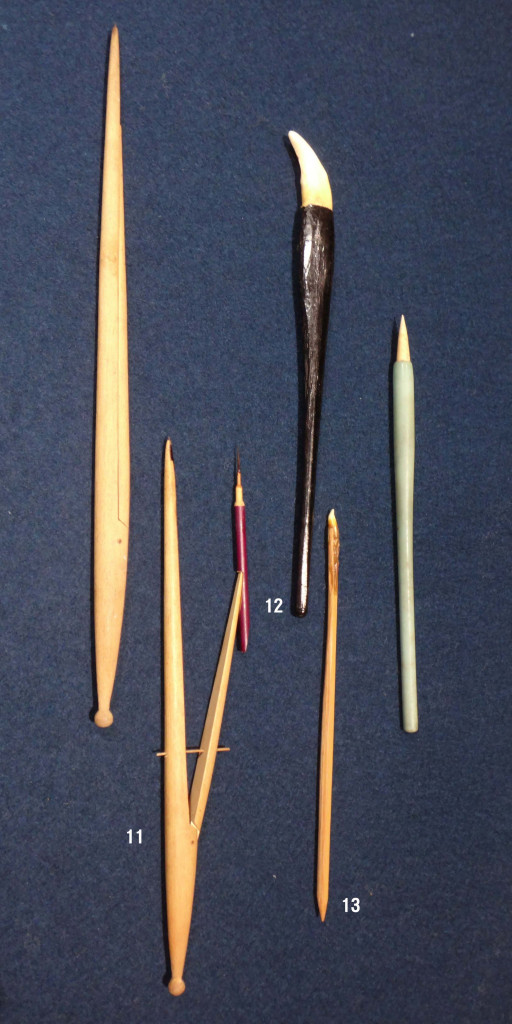
11:Bunmawashi (compass): A tool to draw a circle, it can hold a maki-e brush instead of a pencil.
12:Kenki (dog’s fang): A tool with a dog’s fang at the tip. In maki-e, in the final polishing after sprinkling gold or silver powder, the tool is used to polish detailed parts where the polishing charcoal cannot reach.
13:Taiki (sea bream tooth): A tool with a tooth of a sea bream at the tip. When making a raised maki-e, the tool is used to polish impressions that cannot be reached with a finger.
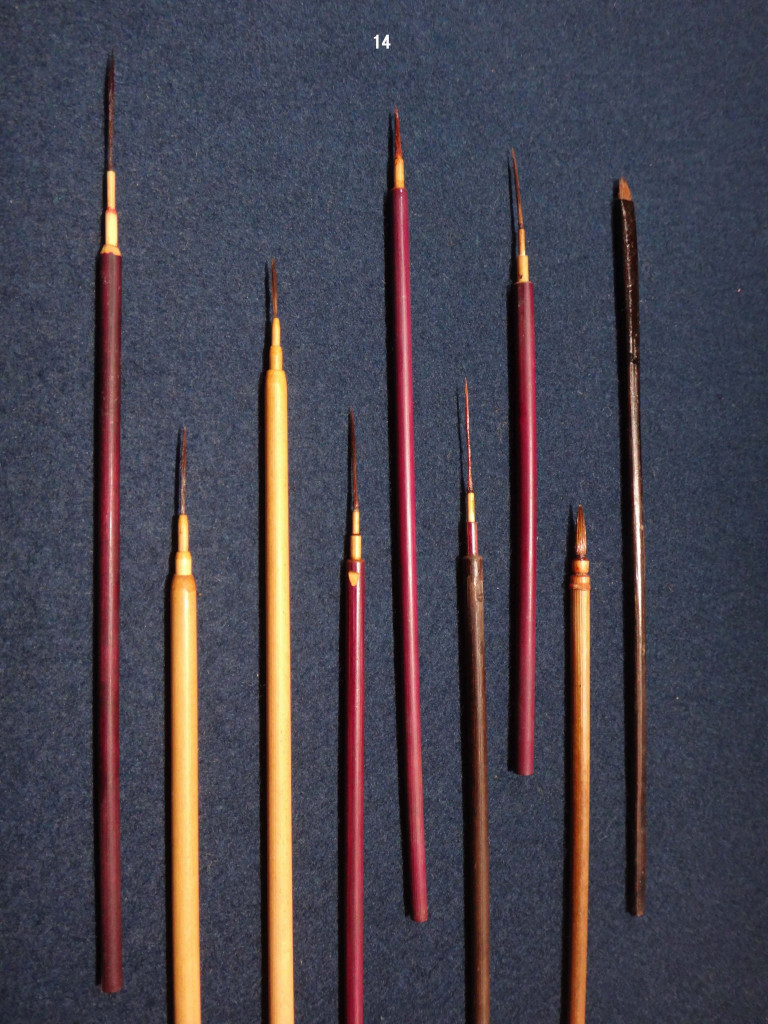
14:Various maki-e fude (decoration brushes): Because maki-e fude are used with viscid lacquer, their bristles are longer (usually 2.5 cm or so) than those of painting brushes. This, however, leaves them flexible and difficult to control. Hairs of rats and cats are mostly used.
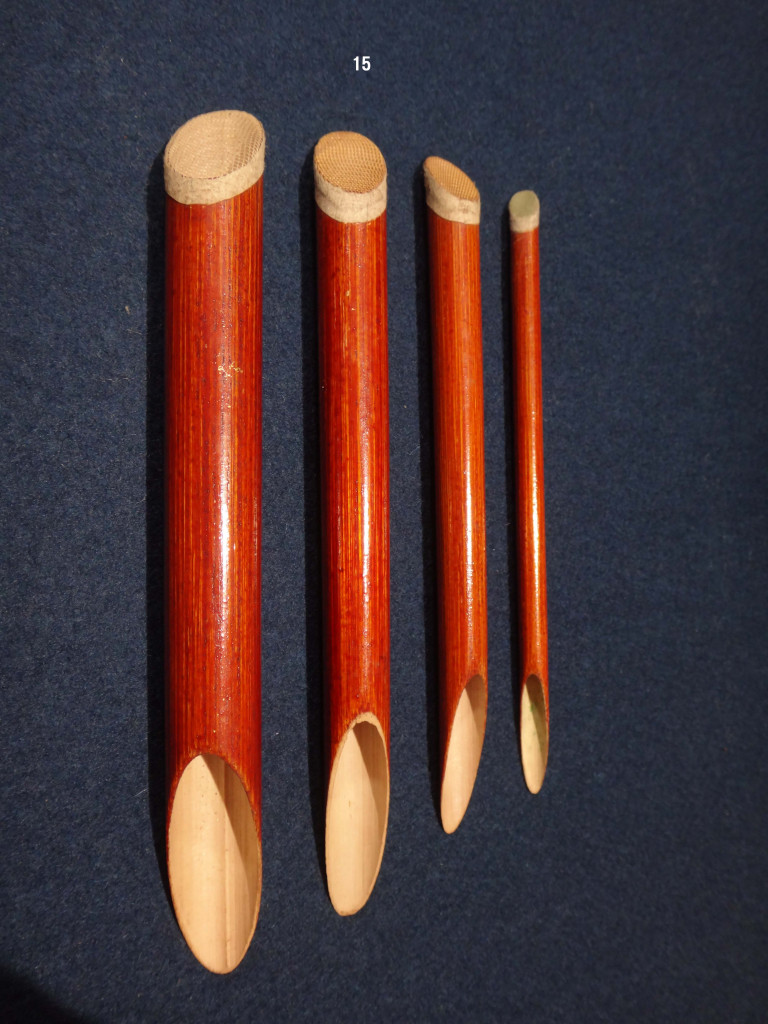
15:Fun-zutsu (powder pipe): Thin pipes are used to sprinkle gold or silver powder in maki-e. One end of the pipe is diagonally cut at roughly 45 degrees and the cut is covered with a piece of sha cloth, or, for very fine gold powder, thin silk. There are two types: bamboo (for coarse, larger powders; cut between the bamboo joints and shaved to be as thin and light as possible); and bird quill (for finer powders; made of swan or crane quills). A variety of results are possible depending on how the pipes are shaken, the angle, and the distance from the surface. In anticipation, the artist will make the pipes manually and prepare multiple versions.
☞ Structure of maki-e fude
maki-e fude are structured so that the bristles are removable. The picture shows that the bristles have been removed from the ferrule. The heel of the bundle of hairs is tightly tied, doubly or triply, and can then be moved in or out to adjust the length of the belly. With a long belly and sufficient lacquer, a long line can be drawn. Adjusting the bristles to be shorter allows small, precise movements, such as the drawing of tiny circles. Usually, to avoid frequent adjustments, the belly of each new fude (fude-oroshi) is decided when the artist begins to use it.
Care of maki-e fude
After a maki-e fude is used, it is cleaned before the lacquer dries, using non-drying oil such as seed oil and a spatula for the purpose, called an “arai hera” (see Exhibit No. 9). If the fude is left in a state where the bristles are bent, the belly, too, is bent and becomes useless. The brush must be treated with the utmost care so that the bristles are always straight. The belly must also be maintained with oil to prevent it from getting dry; the oil must be removed with alcohol before it is used. Care of tools before and after production is essential in maki-e work.

3rd shelf
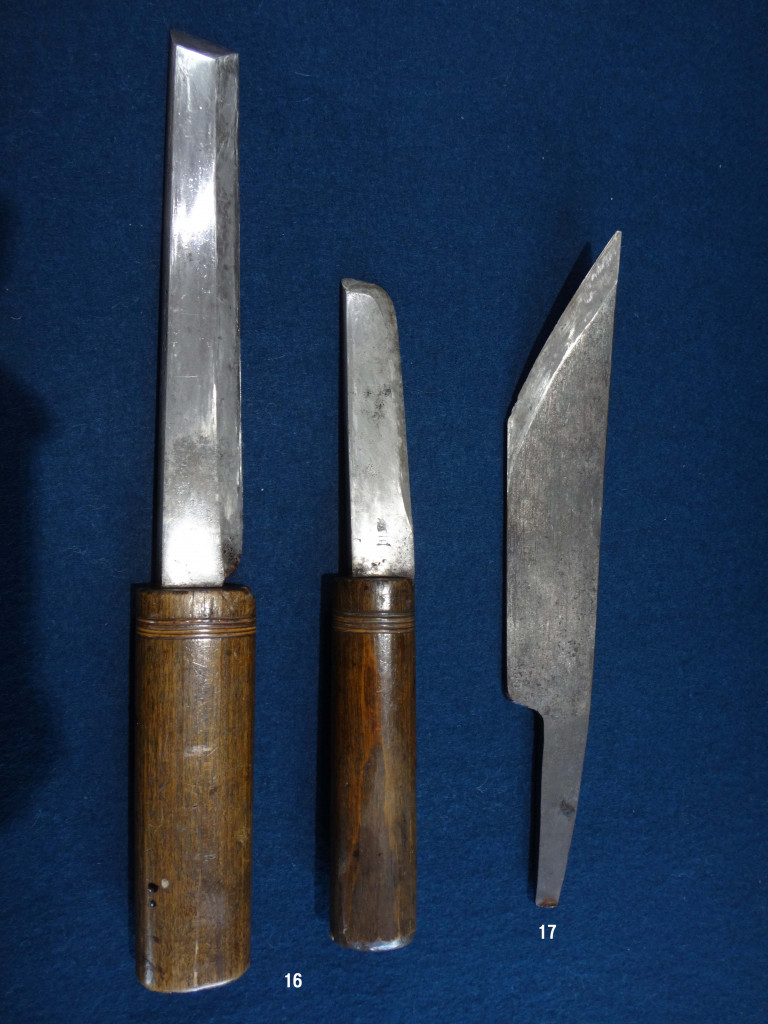
Tools
16:Knives used to shave a spatula or scrape off dry lacquer, called a lacquerer’s knife (nushi-gatana)
17:Yari-kan’na (spear plane): A tool to plane wood, used for smoothing the surface of wood prior to the Momoyama Era. The resulting surface, however, seeming smooth at a glance, looks actually something like having been finished with a chisel. Recognizing this, in turn, as something of “indescribable beauty of form,” MATSUDA Gonroku adopted use of yari-kan’na in his work. Since the Keicho Era (1596 – 1615), when the current type of plane – a cutter attached to spline – appeared, woodwork techniques have progressed substantially.
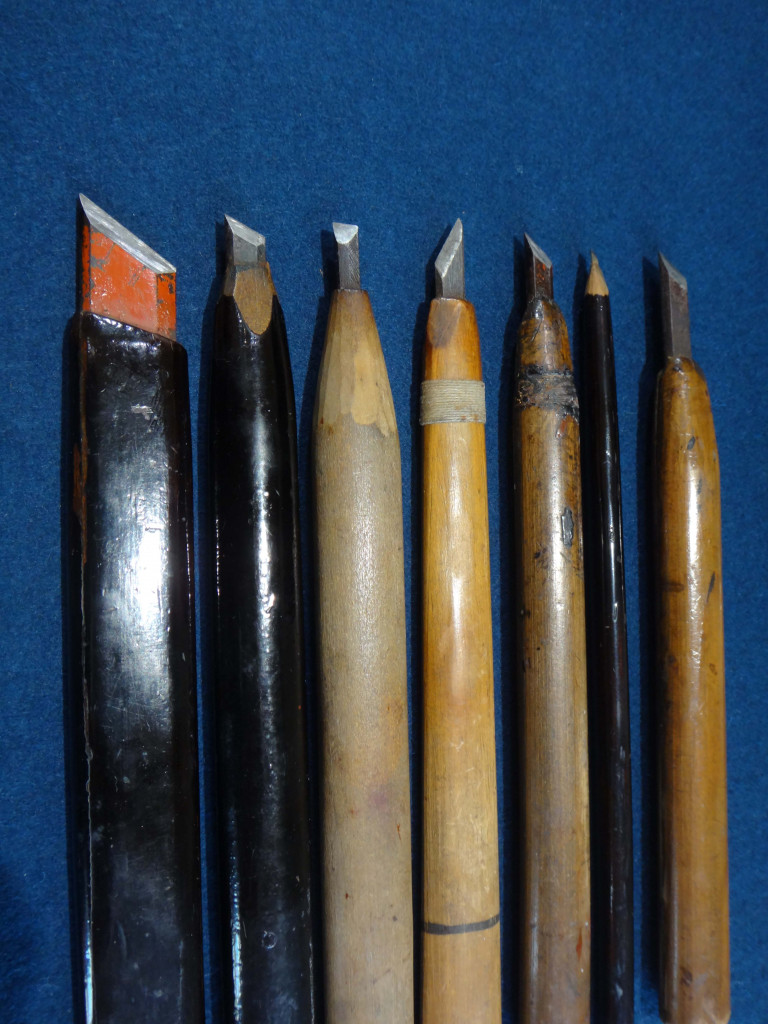
18:Chisels and cutting knives
4th shelf
Articles owned and used by the artist
19:Felt hat
20:Wristwatch
21:Writing utensils
22:Glasses
Middle showcase
1st shelf of the middle showcase
29:OBA Shogyo : “Tray, plover design, hyomon” , 1977
2nd shelf of the middle showcase
30:MASUMURA Mashiki : “Tea caddy in the shape of flower, kanshitsu” , 1986
31:MASUMURA Mashiki : “Tea caddy, cinnabar lacquer” , 1981
32:MASUMURA Mashiki : “Tea caddy in a chrysanthemum design, cinnabar lacquer, kanshitsu” , 1985
3rd shelf of the middle showcase
33:TAGUCHI Yoshikuni : “Large tea caddy, Sky over the Forest, maki-e” , 1983
34:TAGUCHI Yoshikuni : “Tea caddy, chrysanthemums design, maki-e” , 1987
35:TAGUCHI Yoshikuni : “Tea caddy, bell-flower design, maki-e” , 1991
4rd shelf of the middle showcase
36: HIMI Kodo : “Tray for smoking accessories, mulberry wood”, 1965
5th shelf of the middle showcase
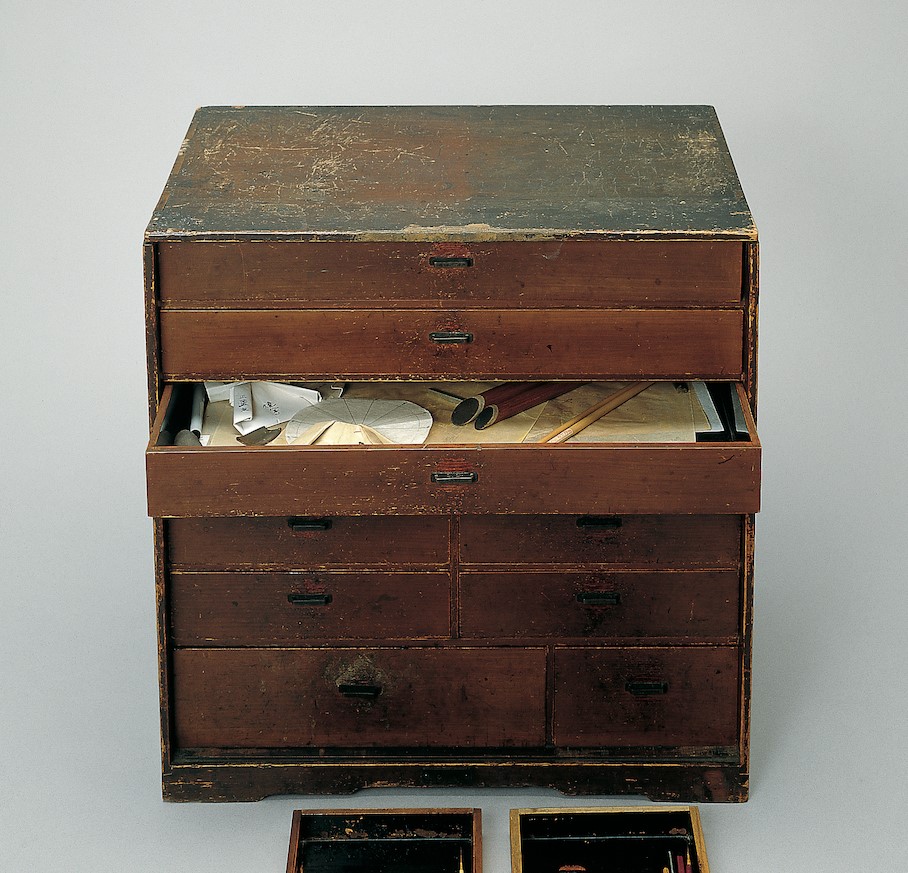
A drawer of powder cabinet
The 2nd and 3rd drawers of the cabinet were removed by the artist and used beside him as powder trays during his maki-e work.
23:Fun-chin: A paperweight for holding folded-paper packages of maki-e gold and silver powder.
24:Fun-saji: A small spoon for spooning maki-e gold and silver powder.
25:Fun-zutsu: Powder pipe made of a bird quill (see also Exhibit No. 15).
26:Tsume-ban: A small palette for lacquer when working on maki-e. It is worn on the left-hand thumb.
27:Ashirai-kebo (treatment brush): When sprinkling powder in maki-e, the brush is used for sweeping the powder in.
28:Harai-kebo: A brush used to remove dust.
Right showcase
1st shelf of the right showcase
37: KAWAGITA Koichi : “Large round tray, clear lacquer on zelkova wood,” 1961
2nd shelf of the right showcase
38: OKUDE Jusen : “Covered food box of chrysanthemum flower , kanshitsu” , 1961
3rd shelf of the right showcase
39: MATSUDA Gonroku : “Serving dishes, pine design, maki-e”, 1965
4th shelf of the right showcase
Materials used for maki-e
40:Turbo marmoratus
41:Shell sheet
42:Abalone
43:Mexican abalone
44:Egg shell (Quail)
45:Ivory
46:Various materials for hyomon


